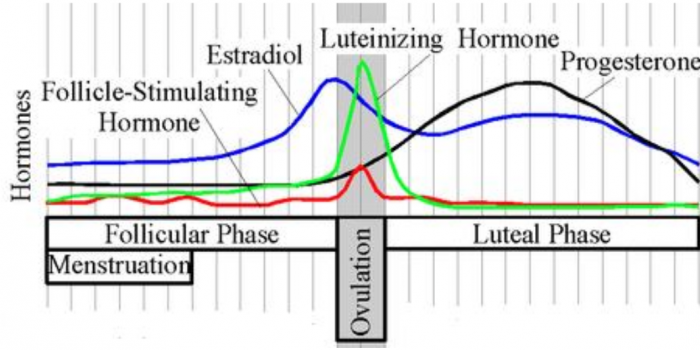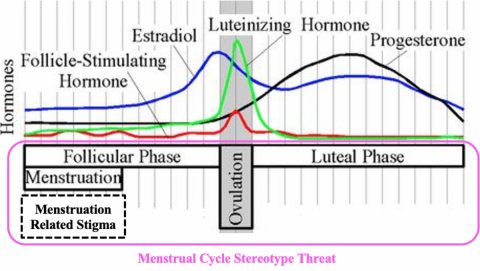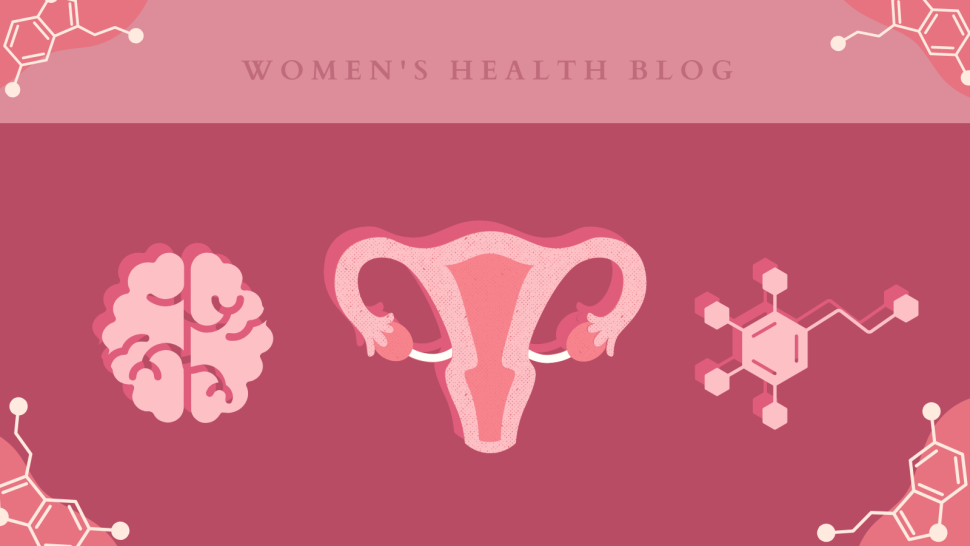Author(s): Kiranjot Jhajj (B.Sc., University of Northern British Columbia) and Annie Duchesne (Ph.D., University of Northern British Columbia) Editors: Negin Nia & Romina Garcia de leon (Blog Co-coordinators)
Published: July 29th, 2022
Research investigating relations between the menstrual cycle and women’s behaviours has a controversial history. It is rooted in attempts to demonstrate that women are biologically programmed to be less intelligent, more caring, and more emotional than their male counterparts. While this research and rationale has long been debunked, today’s growing interest in studying the brain and behavioral correlates of the menstrual cycle exists to understand how this phenomenon brings a distinct source of variability to people who menstruate, which remains understudied in fields such as neuroscience.
One dimension of the menstrual cycle that has been increasingly studied in relation to brain and behavior is its hormonal dimension, which encompasses the variations in the ovarian hormones, estrogens and progesterone (see Figure 1), and how these influence reproduction, brain, and behavior. The menstrual cycle can also be investigated as a social phenomenon, which encompasses the attitudes, beliefs, and stigma around menstruation. However, the social and hormonal dimensions of the menstrual cycle are rarely investigated together. Little is known about how the social framing of the menstrual cycle can influence the hormonal dimension and vice versa. We introduce an integrative view of the menstrual cycle as both a hormonal and social phenomenon.

Figure 1. Hormone fluctuations across the menstrual cycle. "File:Estradiol.Cycle.jpg" by The original uploader was Ekem at English Wikipedia. is licensed under CC BY-SA 3.0.
The menstrual cycle as a hormonal phenomenon
While it is established that the menstrual cycle and the related hormonal fluctuations are at play, a significant role in reproduction, a growing body of literature also reveals a role of these hormones in brain and behavior in humans and animals. However, these effects of ovarian hormones on the brain and psychological changes across the menstrual cycle vary. Several studies reveal a dissociation between cycle phase effects and hormonal effects on brain and behavior. One such study found that women with greater baseline inhibitory control were slower to react during the preovulatory phase compared to menses, while those with lower baseline inhibitory control showed the opposite pattern. Such evidence suggests that ovarian hormones may not be the only factors contributing to the effects of the menstrual cycle phases on brain and behavior. Additional factors may also be involved, specifically the related social constructs.
The menstrual cycle as a socially constructed phenomenon
The menstrual cycle is constantly surrounded by stigma. The stigmatized understanding of menstruation is evident across different societies, promoting ideas of menstruating women being unclean and unable to function normally. Further, menstruation stigma leads to negative impacts on those who menstruate, such as hypervigilance, self-consciousness around the need to hide menstruation, and the experience of shame related to menstruation. These stigmatized views can translate to various sources of stress for those who experience menstruation.
The stigmas around menstruation have consequences on how women perceive their periods. For instance, a study investigating women’s beliefs about menstruation in Mexico revealed that participants holding stereotypical views on women believed that menstruating people should follow specific guidelines about daily activities because they can be more fragile during this period. Participants who reported holding misogynistic opinions about women believed that menstruation is “annoying” and that people should hide menstruation to avoid embarrassment. Beliefs about menstruation tend to be negative, putting menstruating people in an unfavorable and restrictive state.
The influence of attitudes and beliefs about the menstrual cycle is not limited to menstruation alone, as they can also affect women throughout their cycle (see Figure 2). For instance, one study found that the mere request for menstruation-related information acted as a stereotype threat that influenced cognitive performance. While stigma can be related to the experience of menstruation, this study shows another similar source of stress, rooted in the awareness of one’s menstrual cycle. Taken together, this evidence outlines the importance of the social dimensions of the menstrual cycle when investigating its effects on the brain and behavior.

Figure 2. Hormone fluctuations across the menstrual cycle, with the addition of where stigma regarding menstruation may be prominent. Menstruation stigma can occur during menstruation itself, whereas menstrual cycle stereotype threat could arise whenever menstruation is mentioned, which is not tied to any specific cycle phase. "File:Estradiol.Cycle.jpg" by The original uploader was Ekem at English Wikipedia. is licensed under CC BY-SA 3.0.
The hormonal meets the social dimension
A majority of the research on the menstrual cycle tends to focus on either its hormonal or social dimensions. We believe that there is benefit in approaching the menstrual cycle as an integrated biopsychosocial phenomenon. Within an integrated approach, it is possible that the stigma activates stress systems and translates to a physiological phenomenon to influence brain and behavior. For example, one study shows that the expectation of stigma based on one’s identity can physiologically alter how one reacts to social stressors. Thus, effects of the menstrual cycle on brain and behaviour may partially be attributed to the stress-related effects of menstruation stigma and menstrual cycle stereotype threat.
Another layer of integration between the social and hormonal dimensions of the menstrual cycle involves the interaction between their respective endocrine systems. Research shows that the stress and ovarian systems can interact, either through mutual inhibition or activation. Through the activation of stress systems, stigma and stereotype threat related to menstruation can influence the hormonal dimension of the menstrual cycle. Inversely, it is also possible that variation in ovarian hormones regulates how individuals react to menstruation stigma and menstrual cycle stereotype threat. Then, instead of considering the social and hormonal aspects as two independent dimensions by which the menstrual cycle influences brain and behavior, it is more productive to study the interplay between the social dimensions and the biological aspects of the menstrual cycle.
Conclusion
As research on the influence of the menstrual cycle on brain and behavior increases, there is an opportunity to consider the multiple dimensions of this phenomenon and how they interact to influence brain and behaviours. The menstrual cycle is a biological occurrence situated within various layers of social context. While ovarian hormones can influence cognition throughout the menstrual cycle, it is also vital to consider that these changes may be affected by the stigma associated with specific phases of the menstrual cycle, which in turn can influence the physiology of people who menstruate.
